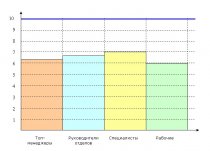Staff Motivation Index

Oleg Kulagin
An important factor in the enterprise ' s productivity is the satisfaction of its employees. Also as customer satisfaction increases their willingness to pay money and to buy their suppliers ' products and services, workers ' satisfaction increases their willingness to work for and for the benefit of their enterprise. Employees ' satisfaction assessment provides important information on how pleased it is
or dissatisfaction with staff, and in what directions the staff incentive system should be improved. It is for this information that well-known methods of satisfaction evaluation are used. However, they can produce distorted results and, as a consequence, result in
to erroneous decisions on staff motivation. This is because existing methodologies do not take into account the personal attitudes of workers towards different motivational factors.
In fact, all factors affecting workers ' satisfaction have different meanings.
for different people, as everyone has unique internal motivation. For example, the employee ' s satisfaction with the " permanent portion of the salary (salary salary, allowances) " may be sufficiently high (see 80-90%), but the amount of the permanent salary for the employee may not be as important as the ability to earn money depending on the results of his or her work. Consequently, the " contribution " of this factor to overall satisfaction should be adjusted in view of its importance to the worker. Well, in our example, it can be 30-40%. This adjustment takes into account the influence of each factor on staff motivation and results in a more accurate assessment of their satisfaction. This means that satisfaction assessment questionnaires should identify not only satisfaction but also structure internal motivation of workers♪ This article proposes a methodology that has been tested.
in several Russian enterprises.
All factors affecting workers ' satisfaction were divided into two groups: supporters and motivations. Under this approach, supporting factors (or restraints) create the necessary (but not sufficient) conditions for the high satisfaction of workers. However, motivating factors can significantly increase the satisfaction of the same workers, subject to all necessary conditions. Both have had some impact on the overall satisfaction assessment, but the extent of this impact may vary. ♪ ♪
In the questionnaire developed, staff were asked to first assess the importance to each of them
of these factors in points ranging from 0 to 10 (critical). The scores then used to calculate the adjustment factors reflecting the relative importance or " share " of each factor in the overall satisfaction of the worker. These coefficients are calculated by standardizing the input estimates of the importance of the factors and are a set of numbers between 0 and 1, giving a value of 1.
Related posts:
 The main purpose of the staff assessment is to keep the manager informed of the professional performance of the staff of the organization and its changes. What are…
The main purpose of the staff assessment is to keep the manager informed of the professional performance of the staff of the organization and its changes. What are… The long-term sustainability of the nuclear power complex, which includes industry, government, regulatory bodies, research organizations and educational institutions…
The long-term sustainability of the nuclear power complex, which includes industry, government, regulatory bodies, research organizations and educational institutions… Motivation and human needs are a process of encouraging yourself and others to work towards the personal goals and objectives of the organization. The effectiveness…
Motivation and human needs are a process of encouraging yourself and others to work towards the personal goals and objectives of the organization. The effectiveness… Even a specialist who has hard to find a job is starting to relax in three to six months of continuous work and needs further motivation: one wage alone cannot sustain…
Even a specialist who has hard to find a job is starting to relax in three to six months of continuous work and needs further motivation: one wage alone cannot sustain… The motivation clause is one of the most important documents, as it records who, for what, gets into the company. This document will establish a pay and bonus system…
The motivation clause is one of the most important documents, as it records who, for what, gets into the company. This document will establish a pay and bonus system… The next key factor in establishing the foundation of the motivational system is the understanding of the management of its basic principles, the key feature of…
The next key factor in establishing the foundation of the motivational system is the understanding of the management of its basic principles, the key feature of… An audit of your restaurant is necessary to determine which sources will generate the greatest income for your restaurant business. Audit will identify the necessary…
An audit of your restaurant is necessary to determine which sources will generate the greatest income for your restaurant business. Audit will identify the necessary… What do you know at Workshop 1. How better to motivate their subordinates. 2. What modern methods of stimulus are you able to put into practice. 3. How to develop…
What do you know at Workshop 1. How better to motivate their subordinates. 2. What modern methods of stimulus are you able to put into practice. 3. How to develop… The growing demand for enterprise business process systematization is primarily due to the main objective of building business processes, the desire to improve business…
The growing demand for enterprise business process systematization is primarily due to the main objective of building business processes, the desire to improve business… Marking approach to personnel management in Russian companies, Contents I. The development of innovative approaches to staff management. The development of innovative…
Marking approach to personnel management in Russian companies, Contents I. The development of innovative approaches to staff management. The development of innovative…